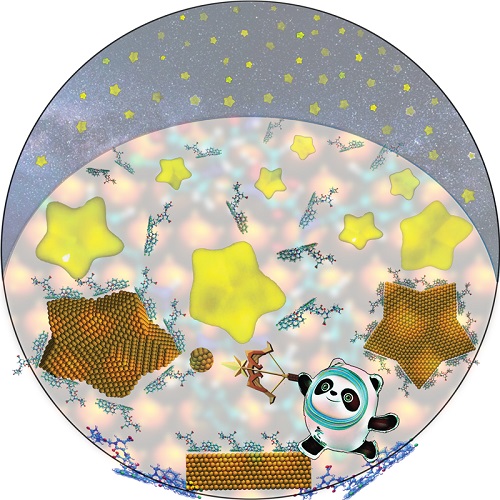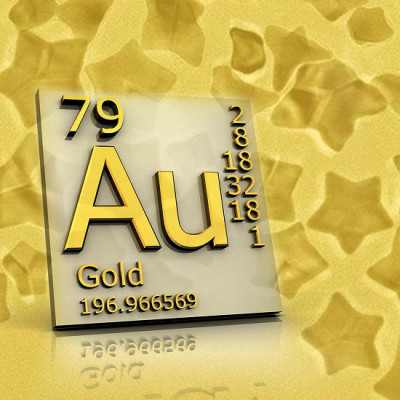Metallic nanomaterials have interesting optical properties, called plasmonic properties, says Chun-Long Chen, who is a PNNL senior research scientist, UW affiliate professor of chemical engineering and of chemistry, and UW–PNNL Faculty Fellow. In particular, star-shaped metallic nanomaterials are already known to exhibit unique enhancements that are useful for sensing and the detection of pathogenic bacteria, among other national security and health applications.
To create these striking nanoparticles, the team carefully tuned sequences of peptoids, a type of programmable protein-like synthetic polymer. “Peptoids offer a unique advantage in achieving molecular-level controls,” says Chen. In this case, the peptoids guide small gold particles to attach and relax to form larger five-fold twinned ones, while also stabilizing the facets of the crystal structure. Their approach was inspired by nature, where proteins can control the creation of materials with advanced functionalities.

Artistic rendering of gold star assembly, by Biao Jin
Jim De Yoreo and Biao Jin used advanced in situ transmission electron microscopy (TEM) to “see” the stars’ formation in solution at the nanoscale. The technique both provided an in-depth mechanistic understanding of how peptoids guide the process and revealed the roles of particle attachment and facet stabilization in controlling shape. De Yoreo is a Battelle Fellow at PNNL and affiliate professor of materials science and engineering at UW, and Jin is a postdoctoral research associate at PNNL.
Having assembled their nanoscale constellation, the researchers then employed molecular dynamics simulations to capture a level of detail that can’t be gleaned from experiments — and to illuminate why specific peptoids controlled the formation of the perfect stars. Xin Qi, a chemical engineering postdoctoral researcher in professor Jim Pfaendtner’s group, led this work at UW. Qi used UW’s Hyak supercomputer cluster to model interfacial phenomena between several different peptoids and particle surfaces.
The simulations play a critical role in learning how to design plasmonic nanomaterials that absorb and scatter light in unique ways. “You need to have a molecular-level understanding to form this nice star-shaped particle with interesting plasmonic properties,” said Chen. Simulations can build the theoretical understanding around why certain peptoids create certain shapes.
The researchers are working toward a future where simulations guide experimental design, in a cycle the team hopes will lead to predictive synthesis of nanomaterials with desired plasmonic enhancements. In this aspect, they would like to first use computational tools to identify peptoid side chains and sequences with desired facet selectivity. Then they would employ state-of-art in situ imaging techniques, such as liquid-cell TEM, to monitor the direct facet expression, stabilization, and particle attachment. In other words, Chen says, “If someone can tell us that a structure of plasmonic nanomaterials has interesting optical properties, can we use a peptoid-based approach to predictably make that?”
Though they’re not to that point, this successful experimental–computational work certainly gets them closer. Further, the team’s ability to synthesize nice star shapes consistently is an important step; more-homogeneous particles translate into more-predictable optical properties.
This work, which was published recently in the journal Angewandte Chemie, stems from a 2019 grant from the U.S. Army Combat Capability Development Command’s Army Research Laboratory to develop design rules for peptoids that produce programmable nanomaterials. It is the product of growing collaborations between UW and PNNL in the materials synthesis space, including the joint initiatives Northwest Institute for Materials Physics, Chemistry, and Technology (NW IMPACT) and Materials Synthesis and Simulations Across Scales (MS3); and research funded by DOE through the Center for the Science of Synthesis Across Scales (CSSAS). These collaborations strongly benefit from the institutions’ dual appointment program.
Read the original article on University of Washington (UW).
